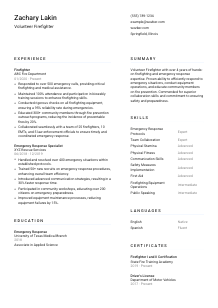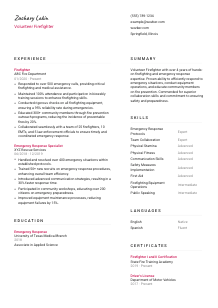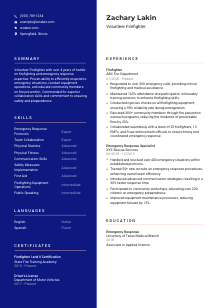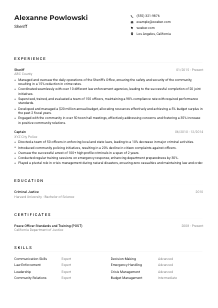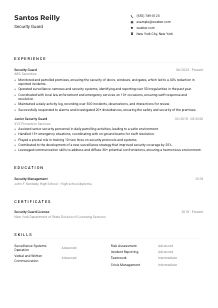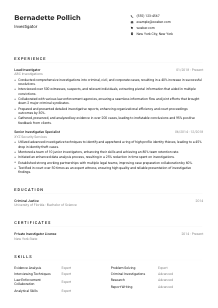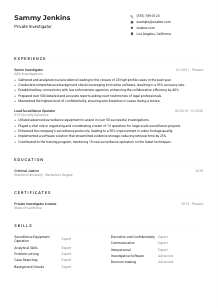Volunteer Firefighter CV Example
Answering the call, but your CV isn't getting through the smoke? Gear up with this Volunteer Firefighter CV example, crafted using Wozber free CV builder. Discover how to sync your life-saving experience with job specifics, ensuring employers see your firefighting talents shine through the flames!
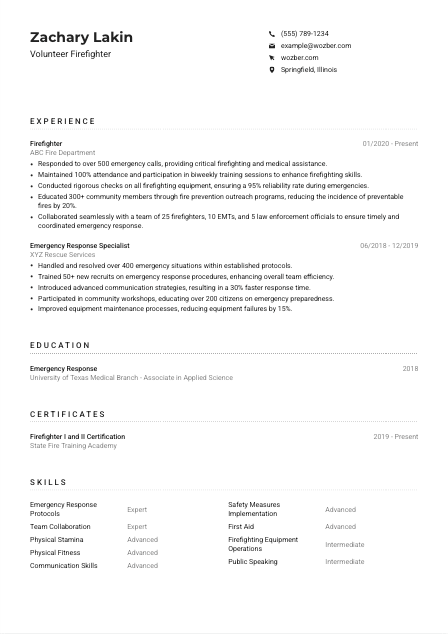
How to write a Volunteer Firefighter CV?
Hello, brave future Volunteer Firefighter! Ready to make a significant impact by serving your community? Your journey starts with a standout CV that screams 'I'm the one you need! ' Diving into the fiery world of volunteer firefighting requires more than courage; it requires a CV that shines through the smoke.
Using Wozber, a free CV builder, we'll guide you through each step to craft a document that perfectly showcases your strengths and is an ATS magnet. Let's ignite your CV writing skills and create a document that lands you your dream volunteer position!
Personal Details
The Personal Details section of your CV might seem straightforward, but it's the address on which your firefighting dreams are mapped. Let's ensure this section is wearing its firefighting gear, ready to make a powerful first impression.
1. Start with a Bang
Your name is your personal siren, so let it be heard loud and clear. Opt for a font that's crisp and accessible, echoing the clarity you'll bring to emergency situations.
2. Job Title Alignment
Echo the job title 'Volunteer Firefighter' directly below your name to create an instant connection, showing you're laser-focused on the role. It's like wearing your badge even before you're officially in the uniform.
3. Essential Contact Details
Ensure your phone number and email address are mistake-free. Your email should sound professional; something as simple as your first and last name can be the first step to being taken seriously.
4. Location, Location, Location
"Must be located in or near Springfield, Illinois" – the job screams. By listing Springfield, Illinois, as your location, you're ticking a major box, showing you're ready to respond to calls without the delays of relocation.
5. Web Presence
A professional profile or website can be the window to your detailed firefighting world. A LinkedIn profile that echoes your CV ensures consistency and demonstrates your networking skills.
Takeaway
Your Personal Details section is now dressed in its firefighting gear, badge shining! This is more than just a formal introduction; it's a promise of reliability and readiness. Keeping it professional and aligned with the Volunteer Firefighter role sets the stage for the impactful narrative that follows.





Experience
The Experience section is where your firefighting battles come to life. Here, we'll showcase your valor and dedication in a way that resonates with what the Volunteer Firefighter role demands. Let's equip it with the best gear to stand out in the firefighting crowd.
- Responded to over 500 emergency calls, providing critical firefighting and medical assistance.
- Maintained 100% attendance and participation in biweekly training sessions to enhance firefighting skills.
- Conducted rigorous checks on all firefighting equipment, ensuring a 95% reliability rate during emergencies.
- Educated 300+ community members through fire prevention outreach programs, reducing the incidence of preventable fires by 20%.
- Collaborated seamlessly with a team of 25 firefighters, 10 EMTs, and 5 law enforcement officials to ensure timely and coordinated emergency response.
- Handled and resolved over 400 emergency situations within established protocols.
- Trained 50+ new recruits on emergency response procedures, enhancing overall team efficiency.
- Introduced advanced communication strategies, resulting in a 30% faster response time.
- Participated in community workshops, educating over 200 citizens on emergency preparedness.
- Improved equipment maintenance processes, reducing equipment failures by 15%.
1. Job Requirements as Your Compass
Start by mapping directly from the job description. For instance, if it says 'Respond to emergency calls,' ensure your experience includes specific instances where you've done exactly that, such as 'Responded to over 500 emergency calls, providing critical firefighting and medical assistance.'
2. Structuring Your Valor
Present your experience chronologically, emphasizing your most recent firefighting adventures. List your job title, the name of the fire department or service you worked with, and your period of valorous service.
3. Accomplishments, Not Tasks
Focus on what you've achieved, not just what you were tasked with. Quantify your successes, like the '95% reliability rate during emergencies' thanks to your meticulous equipment checks, to make your contribution tangible.
4. Numbers Speak Louder
Quantify wherever possible. 'Educated 300+ community members through fire prevention outreach programs' tells a vivid story of your impact in the community.
5. Relevance Reigns Supreme
Stick strictly to firefighting and emergency response experiences. The goal is to paint a picture of an experienced firefighter, not just a general helper.
Takeaway
By now, your experience section doesn't just chronicle your past; it's a testament to your dedication, skills, and potential as a Volunteer Firefighter. It's a clear signal to hiring managers that you're a worthy addition to their team, ready to take on the challenges of the role with zeal and skill.
Education
While firefighting is more about action than academia, your educational background can still fuel the fire of your CV. Let's ensure your education section is ablaze with relevance and readiness.
1. Meeting the Core Requirements
Identify the key educational bullets from the job description. For example, 'Completion of state-approved Firefighter I and II certifications' is non-negotiable, so highlight your Associate in Applied Science degree in "Emergency Response" from the University of Texas Medical Branch in a way that aligns with this demand.
2. Clarity is Key
Structure your education section with simplicity and precision: degree, field, institution, and graduation date. Make it as easy to read as emergency signs.
3. Degree Deets
If the Volunteer Firefighter position asks for specific education, and you have it, flaunt it. Align your achievements with the role's requirements, proving you're not just ready to learn – you've mastered essential lessons.
4. Relevant Courses & Learnings
For roles where your academic journey directly prepares you for the challenges ahead, such as emergency medical training relevant to firefighting, make sure to spotlight these courses.
5. Additional Achievements
If you've excelled in areas closely related to firefighting or emergency response, such as leadership roles in relevant organisations or projects, it's worth a mention. This shows commitment beyond the curriculum.
Takeaway
Your education section now tells a story of a well-prepared firefighter, ready to face the blaze with knowledge and expertise. It underlines that you're not only equipped with practical skills but also the theoretical foundations that can save lives.
Certificates
In the world of emergency response, certifications are your shield. They validate your readiness and expertise. Let's align your certifications with the demanding world of volunteer firefighting.
1. Matching Key Requirements
Begin by ensuring your certifications exactly match the job call. For instance, having 'Firefighter I and II Certification' is the equivalent of holding the key to the firefighting kingdom.
2. Prioritizing Relevance
Keep your certification list populated with items directly relevant to the Volunteer Firefighter role. This isn't just about quantity; it's about showcasing the qualifications that say, 'I'm ready for this!'
3. Dates Matter
Be transparent with the dates of your certifications. This not only shows your continued commitment to staying qualified but also aligns with requirements like the 'Valid driver's license with a clean driving record' by listing it '2017 - Present.'
4. Stay Sharp
The firefighting field evolves continously; so should your certifications. Regularly update your arsenal of qualifications, proving you're not just up to date – you're leading the charge.
Takeaway
Your certifications section is now a testament to your commitment and competence. It's not just a collection of achievements; it's evidence of your unwavering dedication to evolving, learning, and excelling in the art of firefighting. You're not just prepared; you're certified ready.
Skills
Skills are the tools of your trade, and in the fast-paced, unpredictable world of firefighting, they're your lifeline. Let's ensure your skills section is a showcase of your prowess and readiness to serve.
1. Skills from the Heart of Fire
Identify both explicit and implicit skills needed for the Volunteer Firefighter role - 'Strong physical stamina' and 'Excellent communication skills' are prime examples. Ensure your skills section reflects these necessities, showing you're not just fit for the job – you're a perfect match.
2. Focused and Organized
Choose skills that serve as the backbone of your firefighting capability. This isn't about listing everything under the sun; it's about highlighting those skills that make you stand out in a crowd of heroes.
3. The Proof is in the Prudence
Present your skills in an easily digestible format, ensuring the most crucial and relevant skills take center stage. Remember, this section is your quick-reference guide, showing the hiring team at a glance why you're the answer to their call.
Takeaway
With your skills fine-tuned and strategically displayed, your CV now serves as a beacon of competence. You're not just claiming readiness; your carefully selected skills illustrate your preparedness for the challenges volunteer firefighting throws your way. Armed with this arsenal, there's no blaze you can't tackle.
Languages
In a community-centric role like a Volunteer Firefighter, communication can save lives. Let's enhance your CV's language section to reflect not just your ability to speak, but to understand, empathize, and command.
1. Analyze the Call
The job mentions, 'Competence in English communication is crucial.' Place English at the top, confidently labeling yourself 'Native,' affirming that you can command the language with the clarity and authority a firefighter requires.
2. Language as a Lifeline
If you're fluent in additional languages, like Spanish, this could be invaluable in diverse communities. Listing yourself as 'Fluent' in Spanish immediately illustrates your versatility and capability to connect with wider demographics.
3. The More, the Merrier
While not every language might be directly relevant, showcasing your multilingual abilities can be a unique asset. It speaks to your ability to learn, adapt, and understand - valuable traits in unpredictable scenarios.
4. Honesty is the Best Policy
Be clear and honest about your proficiency levels. Overstating your abilities can lead to misunderstandings, while being upfront about your capabilities builds trust from the start.
5. Reading the Situation
Understand the broader implications of your linguistic skills. They're not just for show; they're practical tools that enhance your ability to serve, educate, and protect your community.
Takeaway
With your language skills polished and prominently displayed, you demonstrate not only your ability to communicate but also your capacity for empathy and connection. Your CV shows you're not just a responder; you're a communicator, ready to serve every member of your community.
Summary
The Summary section is where you light the beacon of your firefighting aspirations. It's your chance to shine bright, drawing hiring managers like moths to a flame. Let's ensure your summary radiates with passion, commitment, and readiness.
1. The Fire Within
Begin your summary with a spark – offer a glimpse into your firefighting heart. Stress your '4 years of hands-on firefighting and emergency response expertise,' setting the stage for the narrative of a dedicated firefighter.
2. Responding to the Call
Echo key aspects of the job requirements in your summary. For example, 'Proven ability to efficiently respond to emergency situations, conduct equipment operations, and educate community members on fire prevention' directly addresses core needs of the role.
3. Keep the Flames Controlled
A powerful summary is like a controlled burn – deliberate and efficient. Aim for 3-5 impactful lines that encapsulate your strengths, achievements, and the unique value you bring to the role.
4. Passion Meets Professionalism
End with a statement that highlights your passion for public service and safety, subtly reminding the reader of your commitment to the community and the firefighting profession.
Takeaway
Your summary now stands as a siren call to hiring managers, inviting them to delve deeper into the story of a committed and qualified Volunteer Firefighter. It's not just an introduction; it's a heartfelt promise of dedication and service. With this beacon brightly shining, your CV is ready to ignite your career in volunteer firefighting.
Igniting Your Volunteer Firefighter Future
Congratulations, brave future firefighter! Armed with insights and a carefully crafted CV, you're now ready to march into the firefighting world with confidence. Your CV is more than a document; it's a reflection of your courage, dedication, and readiness to serve. Let it be the spark that ignites your journey. Remember, behind every great Volunteer Firefighter is a compelling story. Use Wozber, your free CV builder, to ensure yours is heard loud and clear.
From crafting an ATS-compliant CV with an ATS-friendly CV template to ensuring ATS optimisation with our free ATS CV scanner, Wozber is here to fan the flames of your potential. Now, step forward with your head held high. The community awaits its newest hero. Go forth and make your mark!

- Minimum of 2 years of experience in firefighting or related emergency response field.
- Completion of state-approved Firefighter I and II certifications.
- Strong physical stamina and ability to pass annual physical fitness assessments.
- Excellent communication skills and ability to work effectively in a team setting.
- Valid driver's license with a clean driving record.
- Competence in English communication is crucial.
- Must be located in or near Springfield, Illinois.
- Respond to emergency calls and provide firefighting and medical assistance as required.
- Participate in regular training sessions to maintain skills and knowledge.
- Conduct routine maintenance checks on firefighting equipment and vehicles.
- Engage in community outreach programs to educate the public about fire prevention and safety measures.
- Collaborate closely with fellow firefighters, emergency medical technicians (EMTs), and law enforcement officials to ensure coordinated emergency response.





